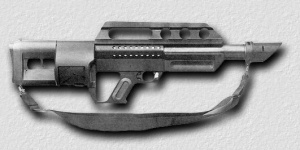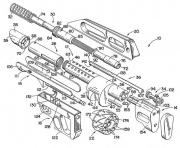Pancor Jackhammer
| Pancor Jackhammer | |
|---|---|

| |
| the Pancor Jackhammer | |
|
| |
| Type | automatic shotgun |
| Land of Origin | USA |
| Specifications | |
| Length | 787mm |
| Barrel length | 525mm |
| Weight | 4.57kg (unloaded) |
| Gauge | 12 gauge |
| Cartridge | any 12 gauge shell |
| Action | gas-operated |
|
| |
| Rate of Fire | 240 RPM |
| Feed | 10-rd removable revolver-type drum magazine |
| Sights | iron sights |
| Production History | |
| Designer | John Andersen |
| Design Date | 1984 |
| Unit Cost | astronomical |
| Produced | never mass produced |
| No. Built | 2 known to exist |
| Variants | none |
Contents |
[edit] Technical definitions
The Jackhammer has often been referred to as "a solution in search of a problem," with some questionable features that can distract any serious military or police buyer.
The weapon, excluding the barrel, is constructed largely of a rynite plastic in order to reduce weight. It features a bullpup layout to preserve a 525mm barrel length in an overall 787mm package. The shotgun is fed by a 10-round capacity center-rotating drum using conventional 12 Gauge cartridges. The shotgun weighs 4.57kg and has a maximum rate of fire of 240rpm. The drum's method of rotation is very similar to the Webley-Fosbery semi-automatic revolver.
The floating barrel is driven forward by gas pressure from the fired round. It is returned by a spring and moves the drum operating rod, breaking the tight seal between the barrel and the drum and allowing the drum to revolve to offer the next round. On the return stroke the barrel and drum are re-sealed allowing the round to be fired without loss of gas. Spent cartridges are not ejected, remaining in the magazine.
[edit] Gas system
The gas system of the Jackhammer consists of the gas cylinder, formed around the movable barrel. The gas piston is formed by the collar, fixed to the barrel just ahead of the gas port that feeds the gases from the barrel into the gas cylinder. When gun is fired, the powder gases are fed into the gas cylinder and begin to push the gas piston and the whole barrel to the front, against the pressure of the return spring. The return spring is located around the barrel, ahead of the gas piston. When barrel moves forward, it first disconnects itself from the chamber with fired cartridge, and then, continuing to move forward, operates the action rod that connects the barrel and the feed and firing system.
The action rod reciprocates with the barrel and has two downward projections on its rear end. These projections act on the cam slots, cut on the outer surface of the cylinder that contains the ammunition. When barrel and action rod go forward, the forward projection on the action rod rotates the cylinder 12º clockwise. On the backward strike of the barrel and action rod the rear projections rotates the cylinder another 12º to align next chamber with the barrel. At the final stage of the cycle, the rear part of the barrel reconnects itself with the fresh chamber to achieve a gas-tight connection.
At the same time, the rear part of the action rod engages the striker, located behind the upper chamber of the cylinder, and cocks it. If the trigger is still pulled all the way back when the reloading cycle is completed, the sear will be released automatically and gun will fire again. There are no provisions for the dedicated semi-automatic single-shot mode - due to the relatively low rate of fire the single shots can be obtained by the quick pulls on the trigger.
[edit] Feed system
The feed system consists of 10-shot, revolver type detachable cylinders, referred to as "ammo cassettes". The cassette may have 10 chambers for more or less conventional 12 gauge shotgun shells, or may be designed like the "cap and ball" era revolver cylinders.
In the latter case, each chamber is factory pre-loaded with powder, primer and a projectiles of one or another type, then hermetically sealed in the plastic film cover. Prior to loading the "Ammo Cassette" into the gun, one must remove the plastic sealing and then insert the cassette. When all charges from the cassette are fired, it can be disposed of or sent to the factory for reload.
The manual cocking for the first shot and the magazine replace process are controlled by the sliding forward handguard. When the handguard is pulled forward, it engages the barrel and pulls it forward and then back, to cycle the action. To remove the Ammo Cassette, one must pull the trigger half the way back (presumably with the safety engaged?), and then pull the handguard forward. This will withdraw the barrel from contact with the chamber of the cassette and then move the cassette axis forward, so the ammo cassette will be free to fall out of the gun. In the forwardmost position, the slide will be automatically held by the release latch, located at the front of the handguard, thus leaving the shooters' non-firing hand free to insert the fresh "cassette" into its place.
As soon as the ammo cassette is in its place, the shooter must push the slide release, so the barrel and the slide will go back under the pressure of the return spring, locking the cassette in place and cocking the gun. The striker can be manually cocked or de-cocked using the cocking handle, located inside the butt. The barrel of the Jackhammer can be easily replaced by removing the muzzle cover and return spring, then rotating barrel 90º to either side to disconnect it from the action rod and, finally, pulling the barrel out of the gun. The new barrel then could be dropped in and rotated 90º to engage with the action rod. Then goes the return spring and the muzzle cover. The conventional open sights are mounted within the integral carrying handle.
As an interesting additional feature, it is possible to take the drum magazine off the firearm, attach a detonator, and use it as an anti-personnel mine that fires all of the cartridges at once when tripped.
[edit] Legality in the US
The Pancor Jackhammer is fully automatic and thus classified as a machine gun in the United States under the National Firearms Act (NFA) of 1934. As such, they are regulated by the Bureau of Alcohol, Tobacco, Firearms and Explosives. Since all available copies of the Jackhammer were manufactured after the May 1986 deadline imposed by the Firearm Owners Protection Act, any civilian attempting to acquire a Jackhammer would need to be an exporter, manufacturer, or dealer of NFA weapons, or a law enforcement officer. However, since there are reportedly only two Jackhammers in existence, the issue is moot.
[edit] See also
- Combat shotgun
- List of shotguns
- USAS-12, a similar weapon
- SPAS-15
- Saiga-12
- NeoStead 2000
- Atchisson Assault Shotgun
- Armsel Striker
[edit] External links
- No manuals are available for this firearm
- Modern Firearms - Jackhammer
- The Pancor Jackhammer at Movie Gun Services
| Pancor Jackhammer is part of a series on Weird guns | ||
|---|---|---|
| Rifles | Heckler & Koch G11 | CornerShot | Periscope rifle | Krummlauf | 
|
| Shotguns | Pancor Jackhammer | |
| Pistols | Duck's foot | Protector Palm | AF 2011 | |
| Revolvers | Chiappa Rhino | Apache Revolver | |
| Others | AO-46 PDW | Harmonica gun | |

